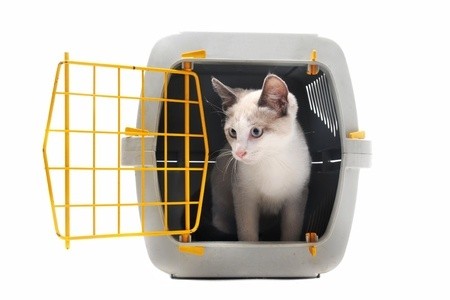
Cat in Transportation Crate
When travelling with your pet by air, it is essential to select an appropriate crate that is safe and comfortable for your pet, and, if flying internationally, one that meets International Air Transport Association (IATA) requirements.
Free pet transport quotes Phone or Email Us
Here are some key considerations when choosing your pet crate:
Number of animals
IATA regulations state that no more than two animals (which must be of a comparable size and weighing no more than 14kg each, and well adjusted to cohabitation together) may travel in the same container. Up to three animals under 6 months old from the same litter may share one container.
It is good practice, however, to provide an individual container for each of your adult pets if you have more than one flying at once, however. Even if your pets are normally placid and gentle in temperament, any animal can become agitated and stressed when travelling, and the potential for aggression is greatly increased.
Size of your pet
Your crate must be large enough to give your pet the room it needs to turn around normally while standing up, and to be able to stand, sit and lie down in its natural position.
To work this out, measure:
- the length of your pet in cm from nose to the root of its tail, excluding the tail itself
- the length of the front leg from the floor to its elbow joint
- the width of the widest part of your pet’s body
- the height from the floor to the top of your pet’s head or the tips of its ears, whichever point is higher
The minimum size of your crate must be:
Length = A + (B x 0.5)
Height = D + 3cm
Width = C + 2cm
If your pet is a brachycephalic (snub-nosed) breed of dog, the dimensions of the crate must be at least 10% larger than those stated above.
Materials and design of the crate
If you are transporting your pet on a domestic flight within New Zealand, you can use a plastic or mesh cage. If your pet is travelling internationally, however, crates made entirely of mesh do not meet IATA regulations. You may be able to use a rigid plastic container at the discretion of the airline you are travelling with, but any wheels must be removed or fully disabled prior to travel. Robustly constructed wooden crates are accepted by IATA and all pet-carrying airlines.
Wooden crates should be constructed with an outer frame of 2.5cm x 7.5cm timber, which may be bolted or screwed together and lined with solid wood or plywood sides.
The floor must be solid and leak-proof; the roof must also be solid but may have ventilation holes; and side walls must be solid but adequately ventilated. Ventilation holes must account for least 16% of the surface area of the container. For wooden crates, the framework must be lined by timber of at least 12mm thickness.
The walls of the crate must be smooth, with nothing protruding that your pet might be able to gnaw or damage.
One whole end of the container must be open and covered with a securely attached hinged or sliding door. This may be constructed from metal (both bars and welded mesh are acceptable, provided the gauge is small enough to restrict paws and noses from being poked through) or plastic (provided the hinges and locks are made from metal of a sufficient thickness).
All crates must have handles or bars along the long sides of the roof.
We recommend you select a professionally built, IATA approved crate for your pet, such as those sold and rented by Aero Pets Ltd. Nobody wants to arrive at the airport with their pet in tow, only to be told their crate is not fit for purpose and their pet cannot fly. If you are planning on building your own, check with your airline first to find out if they will accept it, and pay close attention to adhering to IATA’s Live Animals Regulations.

